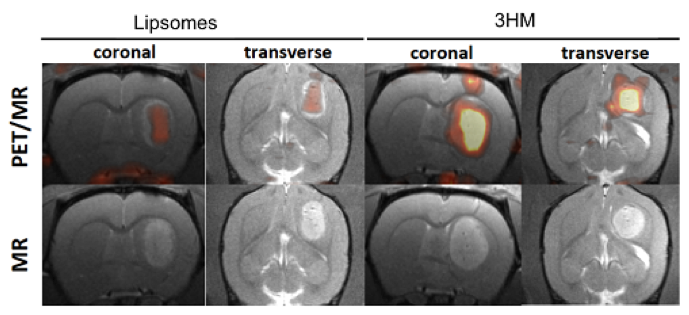Novel Nanocarrier Could Penetrate Blood-Brain Barrier in Glioblastoma
A team of scientists have conducted preclinical trials of a novel drug nanocarrier, 3HM, that may offer a solution to breaking the blood-brain barrier in the treatment of brain cancers like glioblastoma multiforme.
glioblastoma multiforme

Xu Ting, PhD
Breaking the blood-brain barrier has presented a frustrating hindrance for medical oncologists in the treatment of brain cancers like glioblastoma multiforme (GBM). Xu Ting, PhD, of Lawrence Berkeley National Laboratory (Berkeley Lab), in collaboration with Katherine Ferrara at University of California (UC) Davis and Krystof Bankiewicz of UC San Francisco, along with their colleagues, have conducted preclinical trials1of a novel drug nanocarrier, 3HM, that may offer a solution to this obstacle.
Xu, associate professor, Departments of Materials Science & Engineering and Chemistry at UC Berkeley, specializes in design, synthesis, and characterization ofde novodesigned peptides. According to a Berkeley Lab news release, Xu developed 3HM (coiled-coil 3-helix micelles), a new family of nanocarriers, which were formed from the self-assembly of amphiphilic peptides and polymers.
3HM was tested on GBM tumors in rats, and imaged using co-registered positron emission tomography (PET) and magnetic resonance (MR) imaging (Figure). The researchers investigated how a nanocarrier's size affects the pharmacokinetics and biodistribution in rodents with a GBM xenograft in an effort to compare the 3HM nanocarrier with the larger, FDA-approved nano-delivery systems. According to the news release, the team demonstrated that 3HM can cross the blood-brain barrier and accumulate inside GBM tumors at nearly double the concentration rate.
blood-brain barrier in glioblastoma

Figure.PET and MR imaging of mouse models showing coronal and transverse sections comparing conventional liposomal delivery system with 3HM.Courtesy Xu Ting, PhD.
“[The results] showed the feasibility to have nanocarriers accumulate in GBM tumor tissue selectively while maintaining optimal pharmacokinetics and biodistribution. They opened a viable path to access GBM via IV injection therapeutically,” Xu said, in an interview withTargeted Oncology. The findings led Xu and her colleagues to question why 3HM behaves so wellin vivo, whether or not they can fully understand the design principle, and if they can improve upon the design for other neurological diseases.
“Our 3HM nanocarriers show very good attributes for the treatment of brain cancers in terms of long circulation, deep tumor penetration, and low accumulation in off-target organs such as the liver and spleen,” said Xu in the news release.2
The researchers have studied 3HM for other cancer types as well, according to Xu. “Up to this point, all the results are very consistent that 3HM has circulation half-live of about 30 hrs, selective accumulation in a variety of tumor tissue, very deep tumor penetration, and very low accumulation in other vital organs,” she said.
According to the Berkeley Labs news release, GBM therapeutics are transported across the blood brain barrier in liposomes that are approximately 110 nanometers in size; the 3HM nanocarriers developed by Xu and her colleagues are only about 20 nanometers in size. The news release maintained that the smaller size and unique hierarchical structure of the 3HM nanocarriers allowed greater access to rat GBM tumors than did the 110-nanometer liposomes.2
Xu and her colleagues stumbled on the idea for 3HM while studying the hierarchical assembly of amphiphilic peptide-polymer conjugates. She and her group noticed the unusual behavior of the micelles, notably their unusual kinetic stability in the 20 nanometer-size range. She and her team then looked into the critical needs for nanocarriers with these attributes and identified the treatment of GBM cancer as a potential application.1
“I thought our 3HM hybrid materials could bring new therapeutic opportunities for GBM, but I did not expect it to happen so quickly,” said Xu in the news release. Xu has been awarded a patent for the 3HM technology and would like to take this technology to the next level of trials.
“We really want to do further tests of drug-loaded 3HM as potential therapeutics for different types of cancers,” Xu said. “We just need to find partners in the biomedical field who share common interests.”
References
- Berkeley Lab News Center. Nanocarriers may carry new hope for brain cancer therapy. http://newscenter.lbl.gov/2015/11/19/nanocarriers-may-carry-hope-for-brain-cancer/. Accessed November 19, 2015
- Seo JW, Ang JC, Mahakian LM, et al. Self-assembled 20-nm 64Cu-micelles enhance accumulation in rat glioblastoma. J Control Release. 2015;220(28A):51-60.
Neoadjuvant Therapy Could Improve Outcomes for Nasal and Paranasal Sinus Cancer
September 17th 2024Neoadjuvant chemotherapy prior to surgery and postoperative radiation therapy could improve organ preservation in patients with T3 and T4a nasal and paranasal sinus squamous cell carcinoma.
Read More